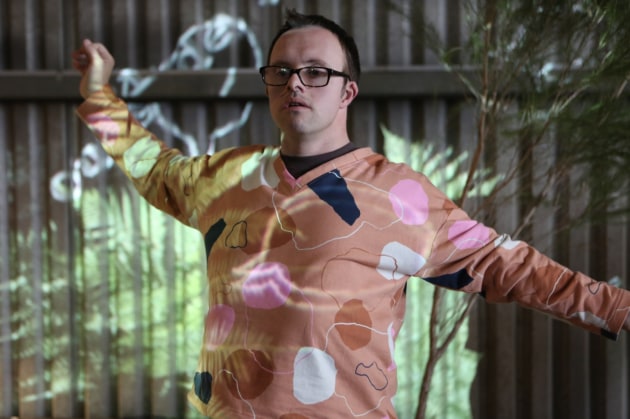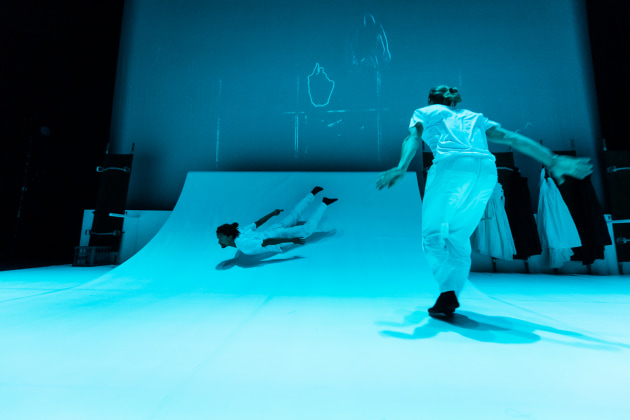REVIEW: Tasmanian autumn offerings
Second Echo, Great Southern Dance and Stompin
Various venues

Three long-term projects came to fruition this autumn in Tasmania.
Outside Boy was presented through Second Echo Ensemble’s focus on developing disability-led works. Its director, Charlie Smith, is one of a core group of SEE artists mentored in the past few years by Creative Director, Kelly Drummond Cawthon.
Outside Boy is Smith’s story and he is at the centre of the action. A group of seven performers, some who "live with disabilities and some do not", help tell his story. The performing space and audience numbers are intimate. At the time of this viewing, the show was held in the SEE studio in Hobart; but as this is a touring show many things will change.
Following a verbal connection with each audience member, Smith’s assistants guide us to take our perimeter-hugging spots in comfy garden swing seats. We are introduced to each of the story-assistants who represent Smith’s elements: Bella Young as "Wind", David Montgomery "Fire", Bethany Reece "Earth", Bryony Geeves and Aidan Chick "Water", Warren Mason "Heart" and Paul Roberts, who gets to represent "everything else". As Smith begins his tale, each of the elements describe his ideas through playful movement. The simple props of basket and rope are manipulated, carving the space and opening up the possibilities of Smith’s imagined world for the all-ages audience.
Each of the walls host projections with which the performers interact. Mimed objects become visible, and the projections appear to "respond" to the performers' actions. The story is accompanied by sound either recorded by Dean Stevenson, performed by Warren Mason and Smith, or accompanied by improvised sound effects by the cast. At its most energetic, with the delightful melee of movement, chaotic sound, audience participation and quickly changing scenes, there is plenty to keep young audiences connected with Smith’s story.
Yet it is often the quieter moments which allow for reflection on the messages of dealing with being an outsider in a world of physical activity; of building resilience and disappointment; of the dominance of noise in which some voices cannot be heard. Not all of the most poignant moments involve movement, but puppetry skills. A clear motif of returning to a central point as a group holds the physical aspects of the work together. Outside Boy has a delightfully simple choreographic form and overall design.

SHOWING AT the Theatre Royal's Studio Theatre, Human Ba La La is the first full-length work created by Felicity Bott and team under the banner of Great Southern Dance. Since basing herself in Hobart, Bott has spent the past couple of years developing this work through residencies at Hunting Ground in the Lower Jordan River Valley, the Port Arthur Historic Site and the Cascades Female Factory/Hobart Rivulet. Findings from these explorations have been previously shared in short installations and film and show strong resonance with colonial themes of built structures, restriction and a human impacted landscape.
Bringing the work to the stage, these themes are sustained with images of dancers caught in tight sandstone walled spaces, camp stretchers, and long, bodiced dresses worn by all five performers. Add to this the full-length score by Dean Stevenson (yes, the same) played and recorded by the Tasmanian Symphony Orchestra, and the references seem clear. Yet Bott does not speak of these things in her program notes. Instead, she speaks of the human autonomic nervous system; of Polyvagal Theory and evolutionary success "stemming from our biological imperative to cooperate and connect with others". So how does an audience connect these ideas?
The set design by Paul Wakelam provides both a striking backdrop and a play space for movement invention. Four dancers (Tra Mi Dinh, Alya Manzart, Gabrielle Martin and Robert Tinning), clad in simple clothes, hover, slip and slide, bounce and dive off a scooped ramp. After the initial deliberate hesitancy to take it on, the dancers look like they are having a lot of fun. Yet there is the constant presence of the camp stretchers either holding a body or propped silently in the background.
Whether accompanying an intricate solo by Dinh with bells, percussive swipes and insect buzz, or accumulating sounds to match the quartet seeking and checking out each other’s bodies, the composition seem to reflect non-human forms, as does the movement. In contrast, we are then shown projected images of a dancer in an ex-penitentiary in a long swirling dress, while those on stage, now dressed in the same type of costume, proceed to march about the space. The messaging has clearly shifted.
The members of the "dressed" quartet are now in competition with each other, as they are with the now live projections filmed from overhead. It is unclear where the audience should look, and which – the screen or live performers – is more important. It seems the audience is now presented with a literal and metaphoric space where command and control are constant issues and dictate the movement material.
The stretcher beds return and a child (Woolf Wakelam) emerges from the lip of the set. He struggles to get up, moves between the bound anguish of the adults and emerges chrysalis-like from his colonial dress. The adults follow suit, and the pace increases as the dancers return to the neutral white costumes of the opening. Dripping effects and flushing water are repeated over and over as the dancers gather force and speed and risk taking on the sloped set. They finally collapse, and the sound of their breathing fills the space. The group then shifts as one. Digitally abstracted through the projections, and on stage, they move as liquid, dividing then merging, only to leave the young performer alone.
A lot is going on here. The many competing layers in this work threaten to overwhelm each other – but perhaps that’s the point?

INTERESTINGLY, Caitlin Comerford, Director of Stompin’s new work HQ, also cites "human resilience, mental health and the spectrum of emotions" as inspiration. In the 30th year of the company, Comerford has enlisted both Joshua Thompson (Legs on the Wall) and Gabe Comerford (Tasdance/ Makeshift) to assist in the physical demands of choregraphing in the potentially challenging environment of a trampolining centre in Launceston.
Most often site-specific, Stompin has yet again created a work that involves the audience climbing, turning and even taking off their shoes if they wish. With two clear groups, the movements of the audience at times become a part of the work or at least an interesting element in the space.
The choice of the site is not an accident (but it looks like there could be many close calls during the performance). As two of the dancers, quoted in the program explain, the work has given them an opportunity to "reflect on the complexities of our own emotional landscapes"; many of which have been challenged in the past two years. So, in a room full of trampolines, what does everyone want to do? Bounce and fall and get up again, a perfect metaphor. The harder you fall the higher you will fly.
It is not surprising that the audience is initially met by rows of radiantly smiling young dancers who are still smiling at the end despite some emotional shifts during the work. In fact, observing their smiles takes up a pleasurable five of so minutes before we move off the explore other areas of the space.
With movement vocabulary based on the physical properties of propel, rebound and suspend, this work challenges some while others are clearly at home in this environment of risk. This equally applies to the audience who can choose to don grippy socks and become obstacles for the dancers to move around and between.
This is an entertaining work with very personal and potentially heart wrenching sections where the young people describe where certain emotions can be found in their body and how these manifest themselves. The original score by Anna Whitaker and lighting by Chris Jackson help lead the audience through the emotional shifts.
- LESLEY GRAHAM
See interview with Felicity Bott about Great Southern Dance here.
Like this review? Sign up to our e-news and receive weekly news and reviews from our team of dance writers around the country.

